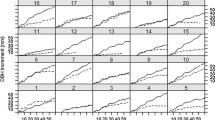Abstract
Intra-annual radial cracks were studied on 294 cross-sections of Norway spruce sampled at two forest sites in the eastern Alps (Italy) and from seven isolated trees in the Jura region (Switzerland). Cracks were occasionally accompanied by traumatic resin canals in the wood that was formed after the cracking. Most of the cracks, however, were without such canals. Traumatic resin canals are not significantly more abundant in tree rings formed after cracking, and their occurrence is not related to the cracking. Cracks developed when the cambium was inactive. Water imbalances during the early spring, due to transpiration losses and inadequate moisture supply from very cold roots, are the likely cause of these cracks.
Similar content being viewed by others
Author information
Authors and Affiliations
Additional information
Received: 21 February 1996 / Accepted: 14 June 1996
Rights and permissions
About this article
Cite this article
Cherubini, P., Schweingruber, F. & Forster, T. Morphology and ecological significance of intra-annual radial cracks in living conifers. Trees 11, 216–222 (1997). https://doi.org/10.1007/s004680050078
Issue Date:
DOI: https://doi.org/10.1007/s004680050078




